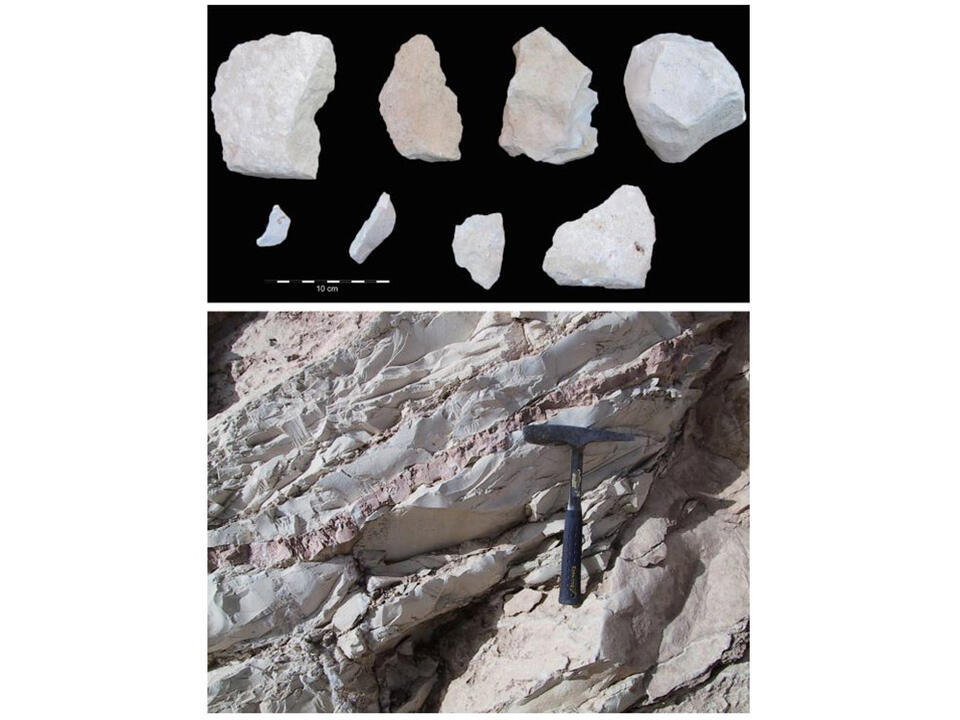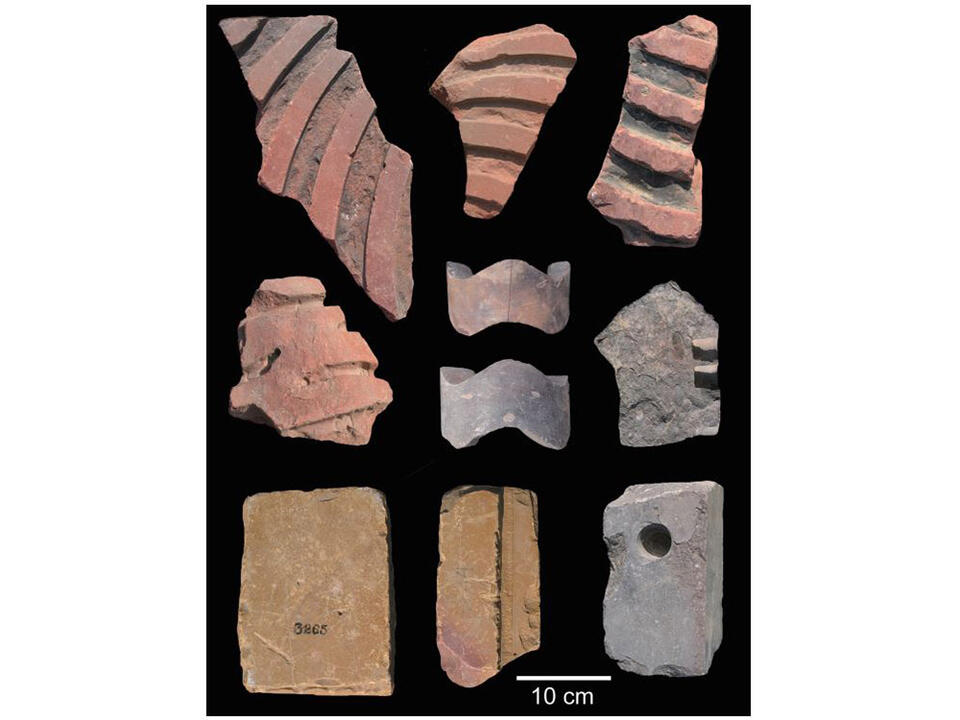Chapter 11: Limestone Acquisition Networks | Download PDF
New Introductory Paragraph by Randall Law, 2024
Although Harappans sometimes used limestone to make beads and other small objects, it was more frequently fashioned into large architectural elements such as ringstones, which were likely the bases of wooden pillars or columns. Small samples were carefully removed from a set of these large artifacts and, using a combination of mass spectrometry and instrumental neutron activation analysis, were compared to limestone from multiple formations in Pakistan and India.
---
LIMESTONE ACQUISITION NETWORKS
Chapter introduction – Limestone
Limestone – a massive rock predominately composed of calcium carbonate – was, on the whole, used to create objects larger than are typically found at Harappa. Some of those objects are “ringstones” and other big pieces of carved rock that probably had some architectural and/or ritual-symbolic purpose. Large pieces of limestone were also evidently acquired for utilitarian purposes, such as the blocks probably used as sewer drain covers. Like grindingstone (Chapter 5), the heavy and unwieldy nature of comparatively large stone artifacts such as these makes examining them especially useful for detecting subtle and sometimes not so subtle, changes in the ability and/or desire of ancient peoples to acquire difficultto-transport heavy stone resources. In addition, the likelihood that some of these large objects were important ritual or prestige-related items provides another dimension with which to examine the ways in which social power was expressed through the consumption and display of stone.
Using ICP-AES supplemented by ICP-MS and INAA, I compare 107 limestone artifacts from Harappa (roughly half of the site’s assemblage for this material variety) to 160 geologic samples collected from multiple locations in six limestone-bearing geologic formations in Pakistan and India. It is revealed that, mainly during Period 3C, Harappans acquired large limestone objects from multiple sources, some as far away at Kutch in Gujarat. This chapter commences with a discussion of the kinds limestone artifacts found at Harappa and other Indus cities. I then provide details on the material properties and possible geologic sources of the five different limestone types most commonly used to make large objects at Harappa. The primary method that was used to characterize artifacts and geologic source material is new and somewhat experimental (Law and Burton 2006b). I therefore present the provenience results in the same exploratory, step-bystep manner in which the data were obtained and evaluated. The implications that the provenience determinations made here have on our understanding of long-distance trade, inter-regional interaction and changing expressions of prestige and power at Harappa is discussed in the summary section that concludes this chapter. Regions, sites and sources mentioned in this chapter are identified in Figures 11.1, 11.14 and 11.16.
The rest of Chapter 11 is in the attached PDF below.
Images
Figure 11.1 Sites and regions discussed in this chapter.
Figure 11.2 [A] Large wavy ringstones at Harappa in front of the tomb of Baba Noor Shah (Naugaza).
[B] Three ringstones excavated in 2010 west of Baba Noor Shah's tomb. [C] Flat-topped micritic limestone
ringstones from Mohenjo-daro. [D] Ringstones from Dholavira on display in the National Museum, New Delhi.
Figure 11.3 Mould terracotta tablets from [A] Mohenjo-Daro and [B] Lakhan-Jo-Daro
that appear to depict composite columns with flat-topped ringstones.
Figure 11.4 Two large conical objects from Harappa composed of white porcelaneous limestone.
Harappa Museum Reserve Collection. Note - 10 cm increments on the scale.
Figure 11.5 Left - Drain at Mohenjo-Daro covered with limestone blocks. Right - Three large rectangular
limestone blocks from Harappa. Harappa Museum Reserve Collection. Note - 10 cm increments on the scale.
Figure 11.6 Unusually shaped red, gray and yellow limestone artifacts from Sahni's excavations (Trench "B")
on the north side of Mound AB. Harappa Museum Reserve Collection.
Figure 11.7 Fragments belonging to composite sculpture of a bovid (bull?)
from Sahni’s excavations on the northeast corner of Mound AB.
Figure 11.8 Large banded flat-topped ringstones (HLS-007 and HLS-008) from Harappa.
Figure 11.9 Flat-topped banded limestone ringstone from Mohenjo-daro.
Figure 11.10 Fragments and broken miniature ringstone (far right)
composed of banded yellow-brown and yellow-brown sandy limestone.
Figure 11.11 Ringstone pieces and miscellaneous fragments composed of bright yellow-red sandy limestone.
Figure 11.12 Ringstone pieces and miscellaneous fragments composed of sandy gray limestone.
Figure 11.13 The "Golden" city of Jaiselmer and details of its limestone architecture.
Figure 11.14 Limestone outcrops in the vicinity of Jaisalmer Fort, western Rajasthan that were sampled for this study.
Figure 11.15 Jaiselmer area limestone occurrences. [A] Mool Sagar Khan quarry. [B] Detail of bright
"golden" yellow Jaisalmer limestone with red patches at Mool Sagar Khan. [C] Detail of reddish banding in the
limestone at Amar Sagar. [D] Banded sandy limestone being quarried at Jethway. [E] Gray, yellow and red
sandy limestone at near Habur, 45km northwest of Jaisalmer Fort.
Figure 11.16 Archaeological sites and Pachchham limestone outcrops in northern Kutch.
Figure 11.17 Sandy yellow banded Pachchham limestone masonry and
slabs in the northern gateway of Dholavira's citadel.
Figure 11.18 Banded Pachchham limestone quarry 3 km north of Dholavira.
Bottom left – Discarded ringstone rough-out. Bottom right – discarded slab.
Figure 11.19 Gray Pachchham limestone near the Harappan site of Juni Kuran, Kutch.
Figure 11.20 Miscellaneous small micritic limestone objects and non-diagnostic fragments from Harappa.
Figure 11.21 Top – White porcelaneous limestone fragments from Harappa. Bottom – White porcelaneous
limestone of the Pahr Formation, Loralai District, Balochistan.
Figure 11.22 Preparing limestone artifacts and geologic samples for ICP-MS and ICP-AES analysis. [A] A
chip (≈ 1 gram) is removed from a from a cleaned, freshly broken surface. [B] The chip is powdered and the
powder is mixed. [C] 0.004 g of the homogenized powder is weighed and placed into a plastic vial. [D] 1 ml
of nitric acid is placed on the sample and left to sit 24 hours. 19 ml of ultra-pure water is then added and the
sample is left to sit another 24 hours. [E] The sample is then filtered of any undissolved mineral particulates.
[F] The liquid sample is then analyzed with an ICP-MS or ICP-AES.
Figure 11.23 ICP-MS analysis of the initial limestone sample set (bivariate plot).
Figure 11.24 ICP-MS analysis of the initial limestone sample set (CDA).
Figure 11.25 INAA of the initial limestone samples dataset.
Figure 11.26 ICP-AES analysis of the initial limestone sample set (bivariate plot).
Figure 11.27 ICP-AES analysis of the initial limestone sample set (CDA)
Figure 11.28 ICP-AES analysis of expanded geologic sample set (bivariate plot)
Figure 11.29 ICP-AES analysis of expanded archaeological sample set (bivariate plot).
Figure 11.30 ICP-AES analysis of expanded geologic sample set (CDA).
Figure 11.31 ICP-AES analysis of expanded archaeological sample set (CDA)
Figure 11.32 ICP-AES analysis of BANDED yellow-brown limestone artifacts (CDA).
Figure 11.33 ICP-AES analysis of BANDED yellow-brown limestone artifacts vs. select geologic sources (CDA).
Figure 11.34 ICP-AES analysis of yellow-red "GOLDEN" sandy limestone artifacts (CDA).
Figure 11.35 ICP-AES analysis of yellow-red "GOLDEN" sandy limestone artifacts vs. select geologic sources (CDA).
Figure 11.36 Box plot comparison of Pachchham quarry vs. Mool Sagar Khan geologic sources and "GOLDEN" limestones artifacts based on discriminant scores.
Figure 11.37 ICP-AES analysis of GRAY and red sandy limestone artifacts (CDA)
Figure 11.38 ICP-AES analysis of GRAY and red sandy limestone artifacts vs. select geologic sources (CDA).
Figure 11.39 ICP-AES analysis of microcrystalline (MICRITIC) limestone artifacts (CDA)
Figure 11.40 ICP-AES analysis of microcrystalline (MICRITIC) limestone artifacts vs. Rohri Hills sources (CDA).
Figure 11.41 ICP-AES analysis of WHITE porcelaneous limestone cones and fragments (CDA).
Figure 11.42 Trenches from which the limestone artifacts analyzed in this chapter came and select artifacts representing the distribution of the different macroscopic types.
The Chapter section titles are:
Large limestone objects at Harappa and other Indus cities
Types of limestone used at Harappa and their potential sources
Sandy limestones
Banded yellow-brown and yellow-brown sandy limestone (BANDED)
Bright yellow-red sandy limestone (GOLDEN)
Gray-red sandy limestone (GRAY)
Three possible source formations for the sandy limestones used at Harappa
Micritic and white chalky-porcelaneous limestones (MICRITIC and WHITE)
Section summary
Geologic provenience studies of Harappan limestone artifacts
Past studies, choice of instrumentation and presentation of data
The archaeological and geologic limestone datasets
Sample preparation, analysis and data evaluation
Pilot study using the initial sample set
ICP-MS analysis of the initial set
INAA of the initial set
ICP-AES analysis of the initial set
Analysis of the expanded set using ICP-AES
Comparisons at the level of geologic formation
Banded yellow-brown and yellow-brown sandy limestone
Bright or “GOLDEN” yellow-red sandy limestone ( Jaisalmer stone?)
GRAY-red sandy limestone
Micritic limestone
WHITE chalky porcelaneous limestone
Section summary
Discussion – Large limestone objects at Harappa in context
Chapter conclusion




